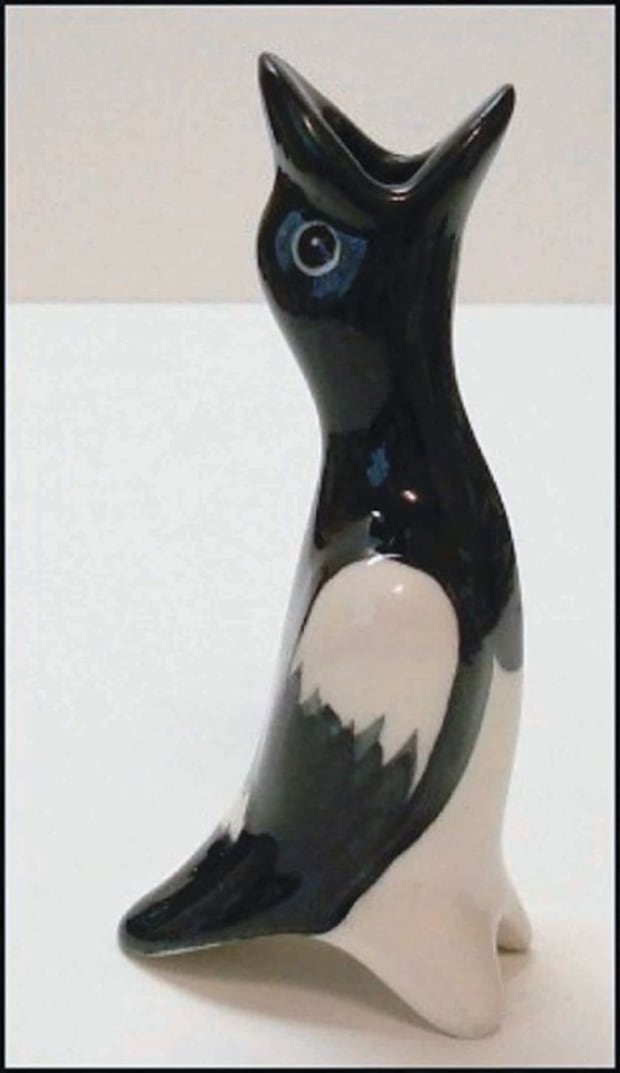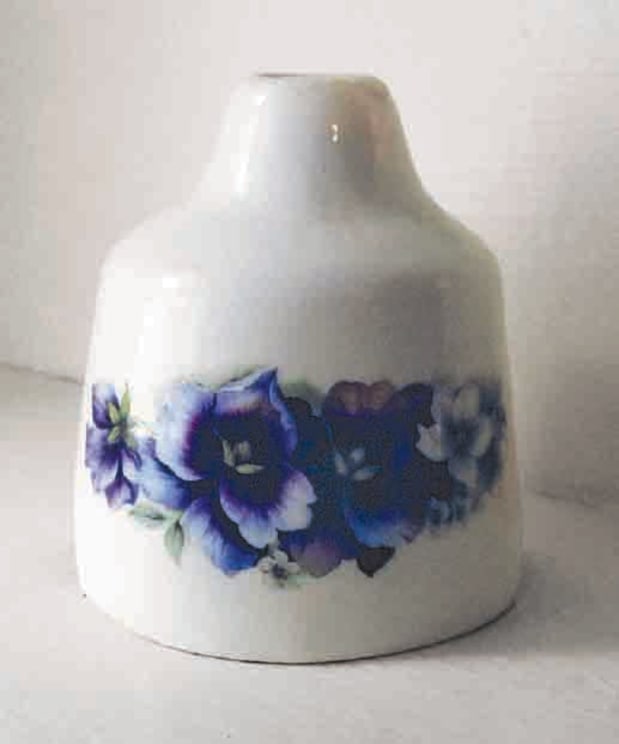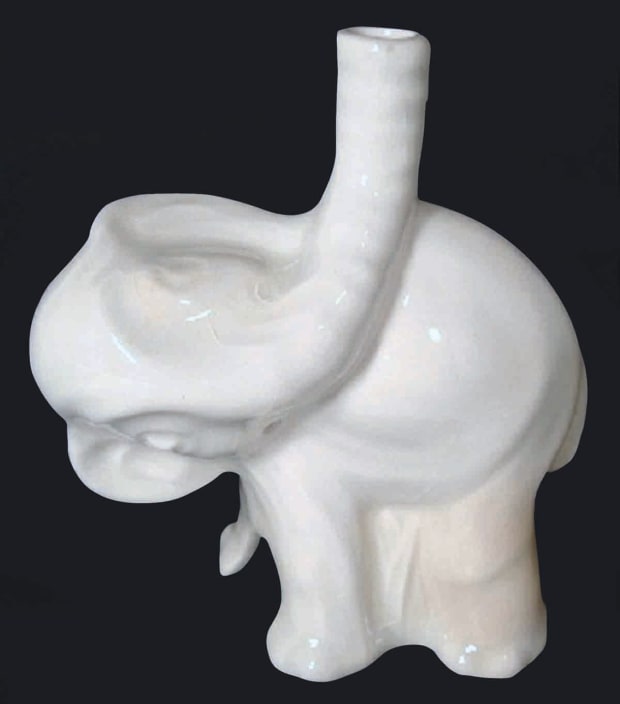#Vintage #Pie #Birds #Functional #Whimsical #Collectibles

All photos are courtesy of David McCormick
The small bird sits there with its neck stretching upward toward the sky. Its beak is wide open, as if singing its melodic song. But this little bird never takes flight, unless it’s one of fancy.
Who doesn’t remember that old nursery rhyme, “Sing a Song of Sixpence?” Four and twenty blackbirds, baked in a pie. When the pie was opened, the birds began to sing …
Does a “pie bird” have anything to do with this old nursery rhyme? As the name implies, pie birds are used in baking pies. They are actually vents, usually made of ceramics, to let the steam escape from the pie as it bakes, and thus they are also referred to as pie vents or pie funnels, as they were known in England. These vents allow the pies to bake without the fruit inside bubbling out and making a mess. Some pie birds will let out a whistle as the steam escapes.

The early pie birds were not shaped like birds at all. They were usually plain, undecorated little pieces of earthenware. Generally, they were round in form with arched openings at the base. When the vent or funnel was placed into the center of the pie before baking, it was those cut out arches that allowed the steam to enter the pie bird and then be released through the opening at the top.

When you conjure up the vision of a pie, you can almost smell the sweet aroma of apples or blueberries drifting up from it. But pies weren’t only baked with fruit filling or other sweet concoctions. Earlier in time, more often than not, pies were baked with some sort of meat filling. Sometimes a local butcher or baker would offer those early pie birds to customers buying their goods. They might have had a marking of some sort or the merchant’s name on them. In those cases, pie birds were promotional items and an early form of advertising.
Over time, these pie birds were manufactured in the shapes of several different figures. Aside from imitating crows, bluebirds, owls, roosters, as well as several of our other feathered friends, pie birds come in all different shapes. They usually measure around three to five inches tall. Today they are found in forms of all sorts such as rabbits, bears, clowns, and folklore heroes. But how did they earn their name, pie bird? Was there any truth to that old nursery rhyme? Was it just a metaphor? Or maybe some ancient recipe called for “four and twenty blackbirds,” when making a pie. There is a sixteenth century English translation in reference to the description of an Italian banquet. To paraphrase: Make a pie crust and put in several live birds. When serving the guests, pull back the top and the live birds fly out, much to the delight of everyone.

There is also the meaning of the word pie itself. In Webster’s New Universal Unabridged Dictionary, the word pie references the magpie’s habit of collecting oddments, or is akin to the word magpie or a related bird.
There are those various references to the origins of pie birds, but most likely their use followed the history of pies. Pie birds are cited in early European history and over the years, they were made by several English potters. During Victorian times, those funnels were often used in baking. Babbacombe Potteries in England produced a number of vintage pie birds starting in the early 1950s and continued making them for several years. Today, there are a number of contemporary English potters that have produced these funnels including Stuart Bass, who has created several series of collectible pie birds. Aside from birds, his characters include dogs, cats, and farm animals, as well as wizards and a unique winged dragon. Each of his pie funnels are created individually. They are modern originals, not reproductions, and are painted by hand. Prices for a Stuart Bass run from $50 and up. The English pottery, Nutbrown, produced several vintage pie birds. Today, examples of their pagoda and elephant pieces made in the 1930s and 1940s can be found from $100 to $150.
By the early 1900s, there were several companies in the United States turning out the bird- and animal-shaped pie vents. The Morton Pottery company opened its doors in 1922 in Morton, Illinois, and was created out of the remains of two earlier potteries. Vintage Morton pie birds from the ’40s or ’50s usually bring from $20 to $75. Shawnee Potteries, another American potter, was located in Zanesville, Ohio, and known for their collaboration with Pillsbury Company. Today you can find vintage pie birds Shawnee produced as premiums for the flour company.

Pie birds were mostly made as inexpensive little items and as such, they were offered for sale in dime stores such as Woolworths and Kresge’s. They were also found in the houseware section of stores like Sears and Roebuck. A California company, Cleminson Pottery, opened its doors in 1941; specifically garage doors, as George and Betty Cleminson began their pottery business in their garage. Along with pie birds, they also made other kitchenware items. The company grew, but ceased operations in 1963 due to the influx of cheaper items from Japan. Vintage Cleminson pie birds start in the neighborhood of $30.

Today there are a number of companies producing pie birds, some large, some small. You’ll also find individual artisans or small craft groups working from their homes creating their original designs.
Pie birds can be classified as kitchen collectibles, but because of their popularity, they have earned their own category. Today they are highly collectible and there is a wide range in price, starting around $10 for newer ones, and $30 to $75 for the 1940s-1950s vintage examples or high-quality contemporary specimens. The rarer, older ones can cost hundreds of dollars.
As with any ceramic, condition reflects in the price, and chips and cracks will detract from the appearance of the piece. True to their name, the ones in the form of birds seem to be more popular than other categories. This becomes obvious after a quick check on eBay. Pie birds are in demand by collectors in several fields. Those interested in the aforementioned broad category of kitchenware seek out these pie birds for their collections. Those collecting certain potters, or countries of origin, such as the United States or England, will find several offerings of pie birds available. Subject matter is another important aspect to certain collectors. If a topic can be imagined, most likely there is a pie bird for that theme.

There are reproductions of vintage pie birds, and should be sold as such, but many times, they’re not. For example, one might be offered for sale as an original “vintage” $30 or $40 pie bird, when they’re not and are worth no more than $10. Some manufacturers have their pottery mark, which helps identify the maker. Some do not. On many of the older authentic ones, the arches are cut deeper in order to allow the steam to enter the base of the funnel, while on a number of the purely decorative birds, the arches are much shallower. Standard colors and designs used by certain pottery companies can also help in verification. It would be wise to look at Linda Field’s Four & Twenty Blackbirds Vol. 1 and Vol. 2 for help in identifying and authenticating pie birds.
Aside from eBay, there are several other online stores offering a large number of our avian friends. Pie birds can also be found at local flea markets or antique fairs, and tucked away in antiques shops.
Pie birds serve a two-fold purpose: They are both functional and decorative. When they’re not in use in the kitchen, they may be displayed on a shelf or behind the glass doors of a cabinet.
When guests come for dinner, they will be drawn to the aroma of an apple pie baking, and they’re sure to be entertained when the pie is removed from the oven with the steam spiraling upward from the mouth of the pie bird.
One never knows what type of bird they will see until the pie comes out of the oven and is set out to cool. No matter what part of the country you live in, be it summer or winter, you’re liable to see all sorts of birds. That’s the beauty of pie birds. Their range covers the entire country. Someone living in San Diego, California, might catch a glimpse of a Blue Jay, while someone living down east in Maine could spot a Flamingo.

Sources
Article: “History of Pie,” by Linda Stradley, 2004, whatscookinginamerica.net
Four & Twenty Blackbirds Vol. 2: Pie Birds, A Pictorial Identification & Value Guide, Linda Fields, 2002
Warmans American Pottery & Porcelain, Susan Bagdade and Al Bagdade, 2000
